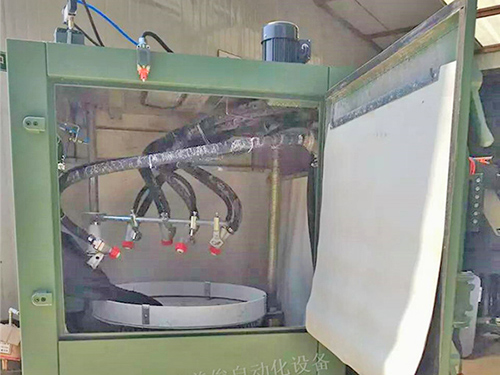1. Mixing water and sand in the
sandblaster will soothe most of the dust! Then reach the environmental protection requirements.
When sandblasting, water and sand contact the surface of the steel structure together, and no sparks will occur when the sand impacts the surface of the steel structure.
The function is the same as dry sandblasting, it can reach sa2.5-3 level
Add anti-rust agent in the tank, the anti-rust powder can be kept outdoors for a week
Simple operation, long-distance operation of 10-80 meters< br>Small footprint, movable with wheels.
The following points should be paid attention to:
(1) Sandblasting interval: refers to the linear interval from the end face of the sandblasting nozzle to the surface of the substrate. With the increase of the blasting interval, the scouring effect of the abrasive on the surface of the substrate is weakened, and the abrasive is dispersed at the same time. The selection of this parameter depends on the blasting method, the air pressure and the specific conditions of the workpiece. Appropriate spacing can not only make the surface reach a certain roughness, but also have a high blasting power, and at the same time, it is necessary to avoid the abrasive to form a large compressive stress on the surface and avoid the deformation of the workpiece. Generally controlled within the range of 100 ~ 300mm. Pressure or blasting intervals are longer than jet suction.
(2) Sandblasting point of view: refers to the angle between the axis of abrasive eruption and the surface of the substrate, which should be kept within the range of 60 to 75 degrees, and 90 degrees should be avoided. To avoid sand embedded in the surface.
(3) Air pressure: powered by compressed air to supply the pressure at the inlet of the sandblasting device. As the pressure increases, the abrasive blasting speed increases, the scouring effect on the surface is intensified, and the abrasive crushing rate increases. Therefore, the selection of pressure should take into account the thickness of the abrasive, the thickness of the workpiece and the requirements of surface roughness. The pressure type sandblasting is generally 0.3-0.5Mpa, and the jet-suction type sandblasting is 0.5-0.6Mpa. Pressure sandblasting should take into account the pressure loss caused by the long sandblasting pipe, and the pressure should be appropriately increased.
(4) Hole diameter of sandblasting nozzle: Under the condition of certain air pressure, the nozzle diameter is enlarged, the air consumption and sand output are increased, and the sandblasting efficiency is improved. The selection of aperture is limited by the amount of air supply, generally 8-15mm. Because of wear, when the aperture of the sandblasting nozzle is increased by 25%, a new nozzle should be replaced.
(5) The moving speed of the sandblasting gun: The uniform roughening surface is obtained by the relative movement of the sandblasting gun and the surface of the workpiece. There is no strict requirement on the moving speed. The sandblasting time is mainly controlled by the uniformity of the surface roughening. Excessive sandblasting time will lead to undesired surface structure. Industrial high treatment grade, also known as white finishing grade (or white grade). The technical standard of Sa3 grade processing: the same as Sa2.5 grade, but 5% of shadows, defects, rust, etc. have to exist.
Derusting sandblasting machine is mainly used to remove oxide scale, welding slag, corrosion layer, old paint, dust, etc., and add the adhesion of the coating together, enhance the service life of the steel structure, and reach the finishing level of SA2, 5-3.0 .
Application scope of water sandblasting machine:
Widely used in hydraulic, ships, valves, petroleum, thermal spraying, pipelines, agricultural machinery, anti-corrosion engineering, steel structures, oil tanks, bridges, large molds, field anti-corrosion, Stone lettering, ancient architectural innovation, glass fiber reinforced plastic and other pre-spraying treatments. Surface finishing of metal workpieces, surface pretreatment, surface cleaning, cleaning of rust, oxide skin layer, oil stain, old paint layer, welding slag, impurities and other surface residues on the surface of metal workpieces. At the same time, make the surface of the metal workpiece have the proper roughness and roughness, and increase the surface adhesion.

